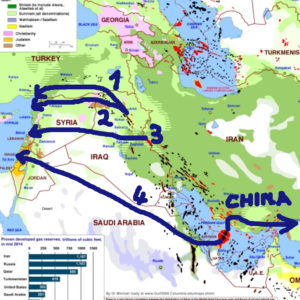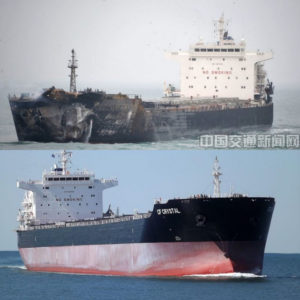
History is alive. At first hand we always have a lie. The lie immediately after the incident is the most believed, the least questioned lie. Time erodes the data but it also helps historians to find new sources. Sometimes a single document changes the whole story, sending a huge library to the trash. History is a relentless inquiry and research discipline. As you plunge deeper into the subject, the more you find out that your knowledge is limited, the more you see that the goose’s foot is more combed than you thought. In that respect History is the “hardest” of all sciences.
On September 11, 2001, the passports of terrorists who had crashed planes into twin towers, were found few blocks afar from the collapsed buildings:

Exploding aircraft fuel melted steel buildings (there are also claims saying that the foundations were dynamited), buildings collapsed to “zero” with the ground, people had evaporated … but these passports found a way to bounce out of that shambles to be found a little away on the street. As we see in the picture above, the ends of both were slightly burnt, one was battered a little further than the other.
We’re laughing today. But people listened to them in those days. Or as Professor Zizek says, they didn’t really believe in it, but they acted as believing in it, since they were believing that everyone else had believed in it.
On June 28, 1914 too, the people of the time believed (or acted as believed) that the assassination of the Austro-Hungarian throne had begun the First World War.
History is alive. At first hand we always have a lie. The lie immediately after the incident is the most believed, the least questioned lie. Time erodes the data but it also helps historians to find new sources. Sometimes a single document changes the whole story, sending a huge library to the trash. History is a relentless inquiry and research discipline. As you plunge deeper into the subject, the more you find out that your knowledge is limited, the more you see that the goose’s foot is more combed than you thought. In that respect History is the “hardest” of all sciences.
The comments on Khashoggi’s murder develop through the controversy of two camps, one which assumes that the incident was a conspiracy against the Prince and the other which assumes that the killling was organised by Prince’s direct orders. Both assumptions are baseless, vain ideological convictions. At least at this stage, no one can claim to know the connection to the Prince. The event could be a plot against Prince; the murder may have occurred directly with the Prince’s instructions; the Prince might have given another instruction while the incident could have resulted in the murder; the Prince may have been misled in contradiction with his objectives and general policy to have been persuaded to give the order of assassination; the murder may have occured for a very different reason that no one could guess in neither being a conspiracy nor being connected with the Prince, but the incident may have then been reverted to serve into conspiratorial purposes. There are infinite possibilities.
The only thing we know for now is that the victim was a journalist who was not effective by his work as a journalist, ineffective by his thoughts and writings. Whereupon we can argue that the killing of Khashoggi may be serving a certain political project more effectively than the effect he created when he is alive. To diagnose what this “effect” would be, we start from the highest determinant moment and gradually progress into the details:
1. USA + Russia Alliance
Today, the first premise to put ahead when we begin reasoning on the Middle East is the following: the two major global players, the United States and Russia, act in full common-interest and cooperation in the Middle East.
The reason of this fact is a new phenomenon: the Shale Gas technology has made the US the world’s largest energy (gas and oil) producer in the last decade. The US has overtaken Saudi Arabia and Russia.
Russia and the Middle East are the geographies where the world’s largest conventional energy reserves are located (Arctic region, Persian Gulf and Mesopotomia). Therefore, Middle Eastern energy exports, are the rivals to both the United States and Russia.
Today, there is an abundance of supply in the energy market. The world is overwhelmed by gas and oil. Despite this abundance, the prices are artificially kept high. The stockpiles and refineries are insufficient to meet the supply.
2. Four corridors competing against each other:
We described the four corridors below in a previous artice. Counting from north to south, the first is Turkey’s, the third is Iran’s, and the fourth is Saudi Arabia + Israel’s project.

The second one, the so-called “Kurdish Corridor” is nobody’s project. Therefore the Kurdish formation here is having difficulty in finding a stable imperialist support behind it.
The most important energy markets are Europe, South Asia and China. USA + Russian alliance therefore tends to -either- block (such as to provoke the Muslim minority in Myanmar) -or- subaltern (such as to persuade Pakistan to build LNG terminals instead of pipelines) the energy routes from Middle Eastern to these main market regions.
Iran is the producer country located at most critical position: it has the potential to spill the Gulf resources both to China through Pakistan and India and to the Mediterranean EU through the first and third corridors.
Qatar is in the joker position: its taking its side next to Iran or next to Saudi Arabia will determine the fate of the fourth corridor.
3. From “Mess Up” doctrine to monopolization project
The emergence of civil war and ISIS in Syria has served as a source of turmoil that had long locked these four corridors. In other words, they served the doctrine of “Messing Up the Middle East resources”. However, the developments falsified again the Leninist imperialism theorist: it has become more difficult to maintain war, than maintaining the peace. The positions of superpowers and local powers on the field limited and narrowed the conflict zones. The region has gained a relative stability.
Since the fight could not have been continued, the plan “B” came into force: Prince Selman was the first Saudi fief visiting Russia. Selman’s agreement with Putin and Trump envisaged the establishment of a new big OPEC, a Trust between the three big energy giants. It was aimed to monopolize the energy suppliers to keep the prices at a high level.
4. Selman Reforms and the conditions for monopolization
Prince Selman’s reformist mission emerged as a result of this unwanted drift of the region towards peace.
The condition of Saudi Arabia’s inclusion in the US + Russia alliance was the liberalization of the country through the investment of oil revenues to infrastructure and social development projects rather than being transferred to the finance and information oligarchy (FANG). The idea was to develop the market potential of the country, not only by its natural resources, but also by its integration into the global capitalist system with its human capital. In the first move, Selman organized operations to the shareholders of Amazon, Twitter, in the overlord family, as jointly in the Transatlantic front another operation against Facebook was organized.
Selman’s reforms were expected to destabilize the regressive Iranian mullah regime too. The support given to Saudi Arabia was bound to the containment of Iran.
Iran, however, was even less resilient than it was thought to be.
5. Iran’s weakness and its disengagement
Iran’s oil exports have begun to decline with Trump’s coming to power In the autumn of 2016. A sharp decline occured since the beginning of 2018. Trump promissed to clear off Iran’s exports.

Iran’s most important clients are Far East countries, China, India, Japan, South Korea, Taiwan. And of course the next door neighbor, Turkey.
They also have customers from the EU. The most important ones from the EU are France, Netherlands and Italy. There are recent news that France and the Netherlands have stopped buying oil from Iran. This attitude of France is particularly important, because Total had always been interested in operating Iranian resources. We attribute this attitude of France not to US hegemony, but to Total’s engagement into new projects in the Arctic Sea in Russia. In times when Total was being managed by its legendary CEO Christophe de Margerie, a bold man brave enough to challenge the US, the world and everyone, had long fought to operate oil and gas in Iranian Persian Gulf’s waters. In this process, Total was sued by plenty of invented cases. In the end, it came out of South Pars Project and made agreements with Russia for operating Arctic basins. Christophe de Margerie was killed in a suspected plane crash in Moscow during this period of his agreement with Russia.
Iran’s most important customer in the Far East after China, India, announced plans to completely cut off purchases from Iran in the coming moths. Japan, South Korea and Taiwan too announced that they would stop buying oil from Iran. We did not investigate separately where each of these countries were planning to compensate the gap, because it is clear that the address would be Russia and the United States.
In summary: the sanctions on Iran are achieving its purpose. But not specifically because of the effectiveness of US hegemony, but thanks to the common interest and cooperation of Russia with the United States!
Another stalemate of Iran is the poor quality of its oil. The quality of oil obtained from the shale gas drills in USA is very high and as a result of the rise of US exports in the past few years the oil quality standard sought in the market has risen. This oil quality is called “light crude oil”. The efficiency of this oil in the refinery’s gasoline production is very high. Iran’s only “light crude oil” source is the Gulf basin shared with Qatar. Total would invest in this basin under the name of “South Pars Project” before heading to Russia.
One shortcoming of light crude oil is that it is not suitable to produce heavy kind of fuels like diesel and aircraft fuel. In order to obtain these products, crude oil should either be heavy or refineries need to be revised to process light crude oil. Still, the real problem with Iranian crude oil is that it is loaded by sulphur.
In the past months, we have read the news that diesel vehicles were to be banned in the coming years (the pretext was again environmental, like saying that they smell bad and so on..). We can think that the main purpose of these new regulations is to support the US exports of light crude oil.
Iran may be facing alternative kind of obstructions other than sanctions as well: in January of this year, an Iranian oil tanker (which brought oil to South Korea) was hit by a Hong Kong-flagged cargo ship. The tanker burned down. 30 Iranian, 2 Bangladesh-citizen of the crew died. In August 2016, a Swiss ship hit another Iranian oil tanker too, but ships could continue on their way.

Below: Cargo ship hitting the Iranian tanker
As we see in the chart above, Iran’s exports are still around 1.7 million barrels a day. With the disengagement of Iran from the suppliers, Russia and Saudi Arabia made statements that they would compensate this gap. Saudi Arabia announced that it could undertake the lion’s share producing a 2.5 million barrels more a day to meet the gap (–we will see whether or not it could do so after the murder of Khashoggi). Russia has announced that it could pump an additional 300 thousand barrels per day and Iraq 230,000 barrels more a day – which explains why Iraq cannot be a strong ally of Iran despite its Shiite government and its considerable Shiite population. That is to say, even if Iran will completely be eliminated from the market, the supply capacity of the US + Russia + Saudi Arabia trust is still too high and this puts down pressure on prices.
The killing of Khashoggi: return to “Mess Up” doctrine?
In this equation, we can think of Iran and Saudi Arabia as brothers whom, the conditions of their existence are connected to each other through their hostility: If Iran is to be eliminated, Saudi Arabia will not be required to take part in the new OPEC trust and will be eliminated too. To describe the event as a struggle for sovereignty/power in the Middle East does not provide a satisfactory explanation. Of course, every political event is a “power struggle”. In order to bring the analysis a bit further, it is necessary to take into consideration the structure of Middle Eastern people and the nature of the fiefdoms there. What is the source of this feudal domination? We are dealing with a geography where the human capital and the capacity to produce science and technology are almost null. Thus the unique source of this feudal sovereignty is energy exports. Therefore we cannot understand events through sectarian-political identities. Despite the well-known stereotype, even the interests of Israel are not effective in this equation – the 4th corridor (TAP) might at any time be cancelled turning the Sunni + Israeli flirting into tension.
Thus we think that Selman had received a hit in this framework.

In the above chart, we see that right after the murder on October 2, 2018, the price had increased and hit to a peak. The previous peak was on July the 3rd. Let’s look at the momentum indicator: the second peak (October the 3rd, the day after the murder) in the indicator is lower than the previous peak (July the 3rd), while the price peak on 3rd October was higher than 3rd July. The indicator shows us that there is a loss of momentum (the so-called “negative divergence”). Technical analysts evaluate such formations as heralds of decline in price. If we assume that the news of the murder was effective on the price rise on 3rd October, we can then deduce that if the murder had not happened, the peak level on 3rd October would not have exceeded the previous peak of 3rd July. The declining peaks (and the falling bottoms) are to be perceived as a trend change (in this case, a shift from the “bull market” to the “bear market”). The murder took place on such a critical day on which the trend change in oil prices were to be questioned.
From now one we can expect further developments that will make Saudi Arabia eliminated from the market (new sanctions on the pretext of murder, etc.). The opposite developments such like Selman’s getting over of the crisis and his continued enthusiasm to reform Saudi Arabia and so on, will however be dependent to the resistance of Iran during this struggle.
Nov 1st, 2018
engin_kurtay@yahoo.com
This article was prepared with the contributions of AliPolaT and Prof Şener Üşümesoy – The Redskin!